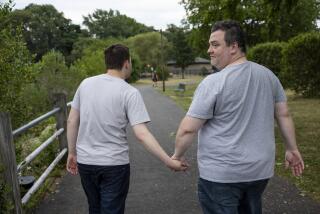Doctors Report Success in Treatment of Autism : Medicine: In preliminary tests, a drug for the first time dramatically reduces children’s symptoms.
- Share via
Physicians have for the first time used drugs to successfully treat autism, a mysterious developmental disorder in which the victims withdraw into a world of their own, seemingly oblivious to people and things around them.
Psychologist Barbara Helen Herman of the Children’s National Medical Center in Washington reported dramatic results in treating 13 autistic children with naltrexone, a drug that is normally used to block the pleasure-enhancing effects of heroin.
She reported Thursday at a meeting of the Society for Neuroscience in New Orleans that the treated children became less hyperactive, made fewer meaningless sounds and had better social interactions. Her results have since been replicated in a smaller group of children by psychologist Magda Campbell of New York University.
The new results are particularly encouraging because the disorder has baffled behavior specialists for decades. Other than behavioral modification, which has had mixed results, there are currently no useful therapies for the disorder, which strikes one out of every 2,000 children.
Herman “is in the forefront of these kinds of studies,” said UCLA psychologist Edward R. Ritvo, an acknowledged leader in autism research. “Her work is very carefully thought out and scientifically sound.” But he cautioned that the work is still very preliminary and must be validated by further studies.
Herman’s treatment “could be helpful in certain kids,” he said, “but autism is a syndrome, not a very specific disease. There could be many causes, and one drug could help only one cause.”
Autism is characterized by a broad spectrum of behavior that includes extreme inattention to surroundings, hypersensitivity to sound and other stimuli, and repetitive motions, such as rocking or twirling around in one spot.
The disorder, which appears to have a genetic component, affects an estimated 300,000 to 500,000 people in the United States, only 1% to 2% of whom ever learn to live independently.
The common picture of an autistic child sitting, isolated, in a corner is a misconception, however, Herman said in a telephone interview. That type of behavior is caused primarily by institutionalization of the children. In fact, one of the primary problems parents have in dealing with autistic children, she said, is that they are extremely hyperactive. “That makes the family situation virtually impossible to manage,” she said.
The cause of autism is unknown, although neuropsychologist Eric Courchesne of the San Diego Children’s Hospital has identified brain abnormalities in children with the disorder.
A growing body of research, pioneered by psychologist Jaak Panksepp of Bowling Green University, links the disorder to unusually high levels of a family of chemicals called endorphins, which are naturally occurring analogs of narcotics such as heroin.
Panksepp and others have hypothesized that endorphins are released into the bloodstream of newborn babies when they are cuddled by their mothers, producing a pleasurable sensation. To a lesser extent, they are also released in social interactions. “Bonding (between mother and child) may be so crucial for social learning that nature made it addictive,” Panksepp said.
But because the autistic infant produces abnormally high levels of endorphins at birth, the child receives no pleasure from bonding with its mother or others and thus has no incentive for social interactions, according to Herman. Moreover, these levels fail to decrease as the child ages, as they do in healthy children.
This suggested that the children might by helped by naltrexone, which binds to brain cells and prevents the endorphins from binding and stimulating their normal response.
Herman and her colleagues, Gail Asleson and Ilaria Borghese, studied 13 hyperactive children between the ages of 3 and 13. They were alternately given the drug and a placebo and their behavior was evaluated by raters who did not know which treatment the children were receiving.
The team found that the children were not only significantly less hyperactive when they were receiving naltrexone, but that they had a much greater attention span as measured by their ability to play with toys. The children’s social interactions with the workers were also improved but, disappointingly, their interaction with their mothers or with familiar volunteers in a playroom setting were not improved.
On overall ratings of autistic behavior, the children’s scores went from moderate/severe to mild. “That is very important,” Herman said, “because clinicians want to know, ‘Does the drug work, yes or no?’ We can now tell them it will reduce the severity. It does not cure autism, it does not make the children normal. But there is a decrease in the severity of symptoms.”
Furthermore, she said, “The importance in the reduction of hyperactivity cannot be underestimated. . . . If you ask parents what they have the greatest amount of trouble dealing with, it’s not the withdrawal or the lack of social interactions, but the fact that they have no impulse control, that they are hyperactive and inattentive. Parents want help to control this,” and naltrexone may be the help they need.
In fact, the drug is so good at reducing hyperactivity that she believes it may also be useful for controlling conventional attention-deficit hyperactivity disorder. That problem is treated with the stimulant ritalin, which has potentially severe side effects, while naltrexone appears to have none of significance. She hopes to begin a clinical trial of this use in the near future.






